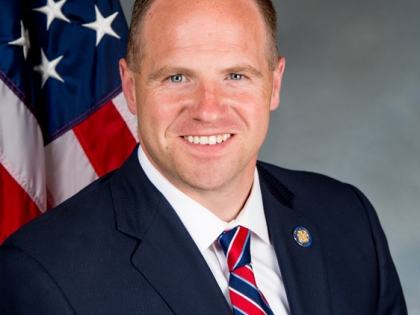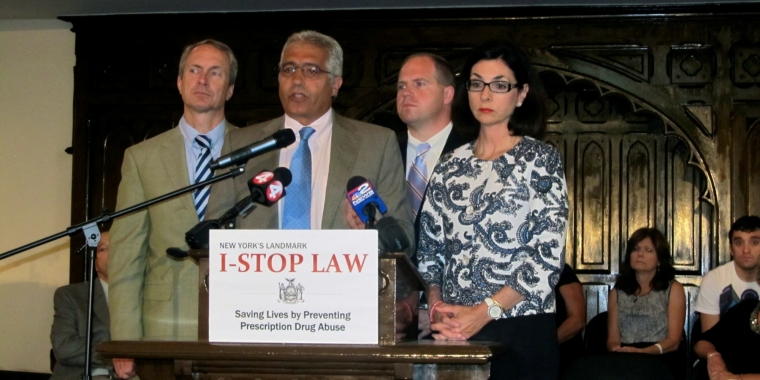
Kennedy and Ryan Mark One-Year Anniversary Of New York’s Landmark I-STOP Law
Timothy M. Kennedy
August 26, 2013

State Lawmakers Announce New Tools, Established with Comprehensive I-STOP law, to Combat Prescription Drug Abuse.
New Online Database Will Help Prevent “Doctor-Shopping”, Stop Drug Abuse Problems Before They Start – Law Was Enacted One Year Ago, Passed Unanimously by NY State Legislature.
BUFFALO – Today, August 26, 2013, New York State Senator Tim Kennedy and New York State Assemblyman Sean Ryan announced the implementation of key provisions of the Internet System for Tracking Over-Prescribing (I-STOP) legislation that was passed last year, and signed into law on August 27, 2012.
The law is aimed at reducing incidents of abuse and misuse of highly addictive prescription medications. With some provisions of the law already in effect, August 27, 2013 marks the implementation of I-STOP’s most revolutionary aspect, the country’s first real-time prescription drug database, known as the Prescription Monitoring Program (PMP) Registry. The PMP Registry is a database that will provide up-to-date information for practitioners to review when researching a patient’s prescription history. Using this information, doctors and pharmacists will have the ability stop a potential drug abuse problem before it starts.
Senator Tim Kennedy said, “Countless Western New York families have been touched by tragedies connected to prescription drug abuse, and the comprehensive I-STOP law we passed last year will help us combat this public health crisis. A year after the bill became law, a critical component of I-STOP now goes into effect – an online system that will allow physicians and pharmacists to check for potential instances of ‘doctor shopping’ or signs of drug diversion prior to writing or filling prescriptions for the most addictive of opiate drugs. This new tool will work alongside other changes initiated by I-STOP to ensure New York State leads the nation in fighting prescription drug abuse. We would not be here today if it were not for the brave local families who channeled grief into action and courageously urged Albany to reform the system to better protect patients. We owe them a debt of gratitude. I-STOP will prevent prescription drug abuse and ultimately save lives.”
Assemblyman Sean Ryan said, “One year after I-STOP was signed into law, a revolutionary new prescription drug database is set to go into effect that will save lives across New York State. The law was passed unanimously by both houses of the legislature thanks to the heroic actions of families whose lives have been impacted by prescription drug abuse. These families came to Albany, and met with legislators repeatedly to emphasize how important it was to change the way the system works in New York. I-STOP would never have become law if they had not stepped forward to share their stories, and personally lobby for changes to the way addictive drugs are prescribed in New York. As important provisions of I-STOP are being implemented, I hope New York’s actions will become a national model for dealing with the crisis of prescription drug abuse and addiction.”
Tasked with maintaining the PMP Registry, the New York State Department of Health (DOH) will protect confidentiality and privacy of every patient by tracking who has access to the information stored in the database. The system is designed to protect the privacy of individuals, and New Yorkers will have access to their personal prescription histories.
According to the Centers for Disease Control and Prevention, over 15,000 people die each year from a prescription drug overdose involving painkillers. Prescription drug addictions have also led to numerous suicides, and other tragedies impacting families across the country. I-STOP helps limit accidental overdoses and stockpiling of prescription drugs by providing pharmacists and physicians with the real-time information they need to safely prescribe drugs to patients.
Many provisions of I-STOP have already gone into effect, including the DOH’s safe drug-disposal program. In February, Hydrocodone (commonly referred to as Vicodin) was moved from a Schedule III drug to Schedule II, limiting the initial prescription for the painkiller to 30 days, and eliminating automatic refill status for first-time patients. A previously non-controlled substance, Tramadol (commonly known as Ultram, Ultracet or Rysolt), was added to Schedule IV on the controlled substances list.
These measures and those slated to go into effect in the coming year will help reduce the incidents of abuse we are seeing in our state. Beginning December 31, 2014, I-STOP’s electronic-prescribing initiative will take effect, requiring practitioners to issue electronic-only prescriptions for highly-addictive controlled substances. Under certain circumstances, waivers and case-specific exemptions will be available. This new system will ensure that all prescriptions make it into the database the moment they are issued, preventing prescription drug abuse via doctor-shopping.
In addition to discussing the new PMP Registry, Kennedy and Ryan also urged local law enforcement agencies to take part in the DOH safe disposal program, and pledged to fight for more funding to expand the program.
Currently, the Kenmore Police Department is the only local police agency in Erie County where individuals can safely dispose of unwanted or expired prescription medications. The New York State Police also monitor a drop-box at Bissell Hall on UB’s North Campus. Across the eight counties of Western New York (Erie, Niagara, Chautauqua, Cattaraugus, Orleans, Wyoming, Allegany, Genesee), there are just five permanent drug drop-boxes. In addition to the two drop-boxes in Erie County, there are permanent safe disposal sites at the Allegany County Sheriff’s Office, the Lockport Police Department and the New York State Police Troop A barracks in Batavia.
The DOH safe disposal program allows any law enforcement agency to sign-up to take part in the program, but participation has been limited since the program’s inception earlier this year. The program allows a law enforcement agency to install a secure drop-box at their station to take in the unwanted or expired prescription medications, which are then incinerated and destroyed. Prescription drug addicts often seek out unwanted or expired prescription drugs that are left unattended in the home. Ensuring that these prescription drugs are properly disposed of will help to prevent needless tragedies.
###
NOTE: For comprehensive information from the New York State Department of Health on the implementation of I-STOP, visit the Department’s Bureau of Narcotic Enforcement website at http://www.health.ny.gov/professionals/narcotic/prescription_monitoring/.
Share this Article or Press Release
Newsroom
Go to NewsroomSenator Kennedy 2023 Veteran Hall of Fame
November 10, 2023



Senator Kennedy 2022 Woman of Distinction
August 26, 2022
